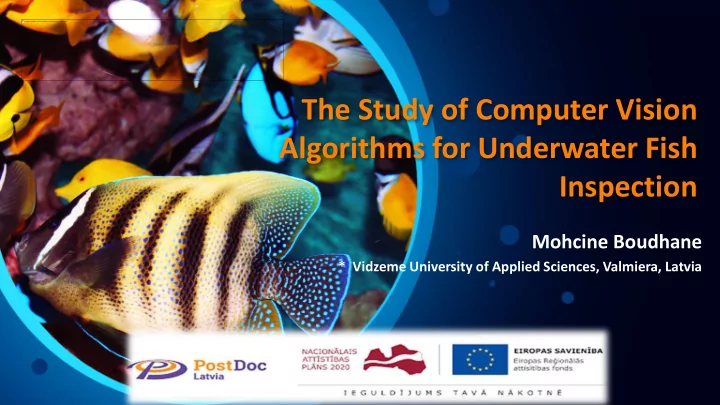

The Study of Computer Vision Algorithms for Underwater Fish Inspection Mohcine Boudhane * Vidzeme University of Applied Sciences, Valmiera, Latvia
Exploring the underwater world (issues) Oceans cover about 70% of the earth's surface. It contains animal, mineral and raw material resources. Exploring its resources is a key topic around the world. Problem: Fish production is getting decreased year by year*: - Intensive fishing (No respect of COTA system) - Disappearance of certain fish species *Reference: http://www.fao.org/fi/oldsite/FCP/en/LVA/profil 2 e.htm 2
Exploring the underwater world (issues) • fishing regularization (rules) Reference: http://www.fao.org/fi/oldsite/FCP/en/LVA/profile.htm • Exploring underwater resources Net casting Fish Divers sampling
Exploring the underwater world (issues) Computer vision is the field that allows a machine to simulate the operation of human vision through the use of sensors (example: camera) Divers: • Not safe • Divers can not reach a certain depth. • Divers can not stay in the water for a long time. Fish sampling/ Net casting: • Kill many fish • No exact accuracy -> Effect No real access of underwater resources ->Proposed solution: Use of Computer vision techniques 4
Why we want to detect fish ? • Fish identification in real environment • Fish assessment • Underwater inspection • Long term supervision -> Fish preservation 5
Data collection • Purpose : Data recording • Location : Gauja river • Duration : 7 days
Problem • Light reflected by an object undergo scattering along its way to the camera.
Problem J is the original light Β scattering effect Effects : light produce a distinctive gray or bluish hue and affects visibility From where ? And what is the cause of those effects?
Problem
What we, fish and cameras see
Underwater issues • Water absrobtion and scatering effects • Light reflexion
Light penetration underwater Open Sea Costal water
Light penetration underwater
Image enhancement • Image enhancement using Dark Channel Prior I(x) = J(x)t(x) + (1 - t(x)) A (1) where, t is the transmission rate, A is the scattering factor of the atmosphere, and d is the depth of the scene. After obtaining the transmission rate, we can use this formula to find the depth of the scene. 𝑲 𝒆𝒃𝒔𝒍 (x) = min 𝒛 ( min {𝒔,𝒉,𝒄} 𝒏𝒋𝒐 ( 𝑲 𝒅 (x))) (2) where is the scattering coefficient of the atmosphere and d is the scene depth. The equation reveals the relationship between scene depth and medium transmission. Orginal Enhanced ( Boudhane et.al*)
Artificial environment
Data Analysis: Shape modelling Two methods: • Shape context (In progress) • Toplogical data analysis. (future work) Objectif: Shape context is a feature descriptor used in object recognition. Description: The shape context is intended to be a way of describing shapes that allows for measuring shape similarity and the recovering of point correspondences. The basic idea is to pick n points on the contours of a shape. For each point p i on the shape, consider the n − 1 vectors obtained by connecting p i to all other points. The set of all these vectors is a rich description of the shape localized at that point but is far too detailed. The key idea is that the distribution over relative positions is a robust, compact, and highly discriminative descriptor.
Data Analysis: Shape modelling Two methods: • Shape context (In progress) • Toplogical data analysis. (future work) Objectif: Representation of a unified model for fish in topological space (non geometric).
Issues Problems: • Sonar system • Fish feeding! Future work: • Make a Computer-aided design CAD of the AUV robot prototype. • Data analysis (Artificial environment) • Theoritical modelling for fish shape
References • Mohcine Boudhane , Ojars Balcers, « Underwater Image Enhancement Method Using Color Channel Regularization and Histogram Distribution for Underwater Vehicles AUVs and ROVs », International Journal of Circuits, Vol:13, pp:571-578, August 2019. ( scopus indexed ) • Mohcine Boudhane , Ojars Balcers, Benayad NSIRI, « Underwater Exploration Issues, Deep Study on Optical Underwater Vision for an Effective Traditional Fishing », ACM digital library, International Conference on Watermarking and Image Processing, ICWIP 2019. ( scopus indexed )
THANK YOU
Recommend
More recommend